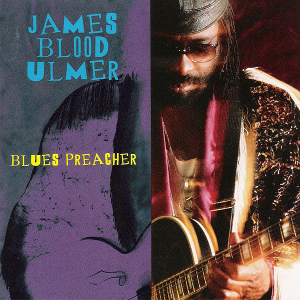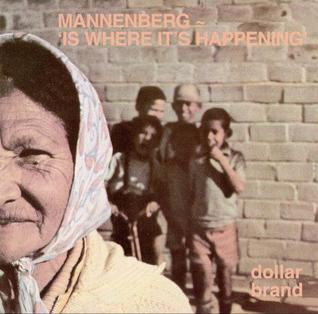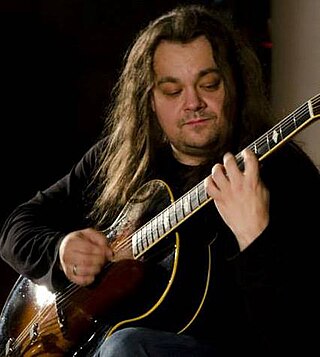
Blues is a music genre and musical form which originated in the Deep South of the United States around the 1860s. Blues incorporated spirituals, work songs, field hollers, shouts, chants, and rhymed simple narrative ballads from the African-American culture. The blues form is ubiquitous in jazz, rhythm and blues, and rock and roll, and is characterized by the call-and-response pattern, the blues scale, and specific chord progressions, of which the twelve-bar blues is the most common. Blue notes, usually thirds, fifths or sevenths flattened in pitch, are also an essential part of the sound. Blues shuffles or walking bass reinforce the trance-like rhythm and form a repetitive effect known as the groove.

Funk is a music genre that originated in Black American communities in the mid-1960s when musicians created a rhythmic, danceable new form of music through a mixture of various music genres that were popular among African Americans in the mid-20th century. It deemphasizes melody and chord progressions and focuses on a strong rhythmic groove of a bassline played by an electric bassist and a drum part played by a percussionist, often at slower tempos than other popular music. Funk typically consists of a complex percussive groove with rhythm instruments playing interlocking grooves that create a "hypnotic" and "danceable" feel. It uses the same richly colored extended chords found in bebop jazz, such as minor chords with added sevenths and elevenths, and dominant seventh chords with altered ninths and thirteenths.

Zimbabwean music is heavily reliant on the use of instruments such as the mbira, Ngoma drums and hosho. Their music symbolizes much more than a simple rhythm, as the folk and pop style styled music was used as a symbol of hope for Zimbabweans looking to gain independence from Rhodesia. Music has played a significant role in the history of Zimbabwe, from a vital role in the traditional Bira ceremony used to call on ancestral spirits, to protest songs during the struggle for independence. The community in Zimbabwe used music to voice their resistance to their oppression, as one of the only weapons they had available to fight back with. In the eighties, the Music of Zimbabwe was at the center of the African Music scene thanks to genres such as Sungura and Jit. However, several performers were banned by state TV and radio leading to the closing of several music venues.

The South African music scene includes both popular (jive) and folk forms like Zulu isicathamiya singing and harmonic mbaqanga. Other popular genres are Marabi, Kwaito, house music, Isicathamiya, Gqom, rock music, hip hop and Amapiano.
Marabi is a style of music that evolved in South Africa over the last century.

Bruce Katz is an American musician, playing piano, organ and bass guitar. From 1996 to 2010, he was on the faculty at the Berklee College of Music in Boston as an associate professor. He founded his own musical group, the Bruce Katz Band in 1991 and has recorded and toured with that band to the present. He has also recorded and toured with many other well-known artists in the Blues, Jazz and Rock music world.
Paul Hanmer is a South African jazz pianist.
Cape jazz is a genre of jazz that is performed in the very southern part of Africa, the name being a reference to Cape Town, South Africa. Some writers say that Cape Jazz began to emerge in 1959 with the formation of The Jazz Epistles, many of whom were from Cape Town, including Abdullah Ibrahim, then known as Dollar Brand. Cape Jazz is similar to the popular music style known as marabi, though more improvisational in character. Where marabi is a piano jazz style, Cape Jazz in the beginning featured instruments that can be carried in a street parade, such as brass instruments, banjos, guitars and percussion instruments.
South African jazz is the jazz of South Africa.

"Locomotive Breath" is a song by British progressive rock band Jethro Tull from their 1971 album, Aqualung.

An organ trio is a form of jazz ensemble consisting of three musicians; a Hammond organ player, a drummer, and either a jazz guitarist or a saxophone player. In some cases the saxophonist will join a trio which consists of an organist, guitarist, and drummer, making it a quartet. Organ trios were a popular type of jazz ensemble for club and bar settings in the 1950s and 1960s, performing a blues-based style of jazz that incorporated elements of R&B. The organ trio format was characterized by long improvised solos and an exploration of different musical "moods".

Louis Mhlanga is a Zimbabwean artist based in South Africa, an award-winning guitarist and producer. Mhlanga taught himself to play the guitar at a young age and is considered one of the best Southern African guitarists.

Sheer Sound is a South African independent record label formed in 1994 by Damon Forbes.

Jazz From the Hills is an album by American guitarist Chet Atkins and The Country All-Stars. It is a reissue of sessions from 1952–1956.
Township Jazz is any of various music genres created by Bantu peoples living in poor, racially segregated urban areas of South Africa ("townships") during the 20th century.

Blues Preacher is an album by the American guitarist James Blood Ulmer, recorded in 1992 and released in Japan on DIW Records and in the US on Columbia/DIW. It was released in North America in 1994.

"Mannenberg" is a Cape jazz song by South African musician Abdullah Ibrahim, first recorded in 1974. Driven into exile by the apartheid government, Ibrahim had been living in Europe and the United States during the 1960s and '70s, making brief visits to South Africa to record music. After a successful 1974 collaboration with producer Rashid Vally and a band that included Basil Coetzee and Robbie Jansen, Ibrahim began to record another album with these three collaborators and a backing band assembled by Coetzee. The song was recorded during a session of improvisation, and includes a saxophone solo by Coetzee, which led to him receiving the sobriquet "Manenberg".

Hallgeir Pedersen is a Norwegian jazz guitarist, well known for his Thorgeir Stubø, Wes Montgomery and Coltrane inspired bop guitar performances and recordings like West Coast Blues (2002) with his own trio.

Black to the Future is a 1998 studio album by South African jazz trumpeter Hugh Masekela. The album was recorded in Mafikeng, South Africa.

Blues Is King is a live album by blues musician, B.B. King. It was recorded in Chicago in 1966 and released by the BluesWay label in 1967.















